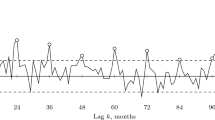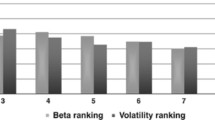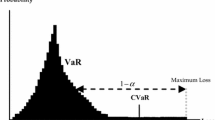Abstract
In this paper, we construct long-position portfolios and zero-investment portfolios to study the returns of stocks with high-or-low trading volume. Distinct from previous literature, this study finds that both high-volume return premium and discount effect exist in the Chinese market while the discount effect seems to be more prevalent. However, the dominance of the low volume return premium is not persistent, suggesting that the Chinese stock market is moving from undeveloped towards developed markets.

Similar content being viewed by others
References
Bai, C. E., Liu, Q., Lu, J., Song, F. M., & Zhang, J. (2004). Corporate governance and market valuation in China. Journal of Comparative Economics,32(4), 599–616.
Bai, J., & Perron, P. (2003). Computation and analysis of multiple structural change models. Journal of Applied Econometrics,18(1), 1–22.
Blume, L., Easley, D., & O'hara, M. (1994). Market statistics and technical analysis: The role of volume. The Journal of Finance, 49(1), 153–181.
Gervais, S., Kaniel, R., & Mingelgrin, D. H. (2001). The high-volume return premium. Journal of Finance,56(3), 877–919.
Goetzmann, W. N., & Kumar, A. (2008). Equity portfolio diversification. Review of Finance,12(3), 433–463.
Gordon, N., & Wu, Q. (2018). The high-volume return premium and changes in investor recognition. Pacific-Basin Finance Journal,51, 121–136.
Huang, Z., Heian, J. B., & Zhang, T. (2011). Differences of opinion, overconfidence, and the high-volume premium. Journal of Financial Research,34(1), 1–25.
Jegadeesh, N., & Titman, S. (1993). Returns to buying winners and selling losers: Implications for stock market efficiency. Journal of Finance,48(1), 65–91.
Kaniel, R., Ozoguz, A., & Starks, L. (2012). The high volume return premium: Cross-country evidence. Journal of Financial Economics,103(2), 255–279.
Lesmond, D. A., Schill, M. J., & Zhou, C. (2004). The illusory nature of momentum profits. Journal of Financial Economics,71(2), 349–380.
Liao, L., Liu, B., & Wang, H. (2014). China׳ s secondary privatization: Perspectives from the split-share structure reform. Journal of Financial Economics,113(3), 500–518.
Merton, R. C. (1987). A simple model of capital market equilibrium with incomplete information. Journal of Finance,42(3), 483–510.
Miller, E. M. (1977). Risk, uncertainty, and divergence of opinion. Journal of Finance,32(4), 1151–1168.
Ning, C., & Wirjanto, T. S. (2009). Extreme return–volume dependence in East-Asian stock markets: A copula approach. Finance Research Letters,6(4), 202–209.
Shanghai Stock Exchange (SHSE). (2013). research on irrational behaviors of equity investors. joint research no. 23 (pp. 1–105). [online]. Available at: http://www.sse.com.cn/aboutus/research/jointresearch/c/c_20130305_3686460.pdf. Retrieved 24 April, 2019 (in Chinese).
Shenzhen stock exchange (SZSE). (2017). The yearly individual Status Survey Report. [online] Available at: http://www.szse.cn/aboutus/trends/news/t20180315_519202.html. Accessed 29 Oct 2019 (in Chinese).
Tian, L., & Estrin, S. (2008). Retained state shareholding in Chinese PLCs: Does government ownership always reduce corporate value? Journal of Comparative Economics,36(1), 74–89.
Wang, C. Y., & Cheng, N. S. (2004). Extreme volumes and expected stock returns: Evidence from China’s stock market. Pacific-Basin Finance Journal,12(5), 577–597.
Wang, P., Wen, Y., & Singh, H. (2017). The high-volume return premium: Does it exist in the Chinese stock market? Pacific-Basin Finance Journal,46, 323–336.
Ying, C. C. (1966). Stock market prices and volumes of sales. Econometrica, 34(3), 676–685.
Zhou, Z. G. (2010). The high-volume return premium: Evidence from the Chinese stock market. Review of Quantitative Finance and Accounting,35(3), 295–313.
Acknowledgements
This work is supported by the National Natural Science Foundation of China (71701150) and Young Elite Scientists Sponsorship Program by Tianjin (TJSQNTJ-2017-09).
Author information
Authors and Affiliations
Corresponding author
Additional information
Publisher's Note
Springer Nature remains neutral with regard to jurisdictional claims in published maps and institutional affiliations.
Rights and permissions
About this article
Cite this article
Zheng, X., Shen, D. The High-Volume Return Premium: Does it Really Exist in the Chinese Stock Market?. Asia-Pac Financ Markets 27, 213–230 (2020). https://doi.org/10.1007/s10690-019-09290-4
Published:
Issue Date:
DOI: https://doi.org/10.1007/s10690-019-09290-4




